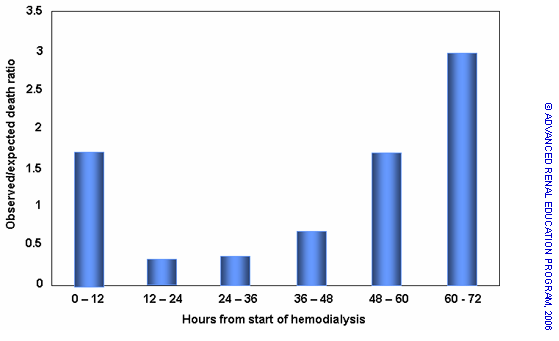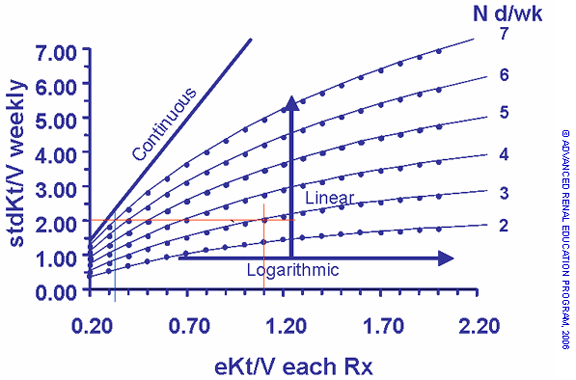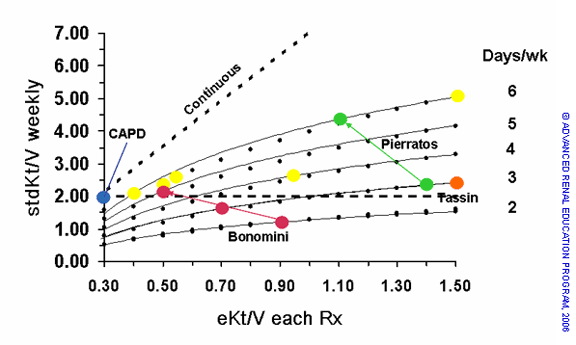Effect of Frequency
There are abundant data to suggest that frequency may be the most important determinant of clinical outcomes, assuming the patient is receiving a minimal or adequate dose of therapy. A fundamental observation in the development of theoretical constructs to correlate frequency and outcomes was the favorable and seemingly similar survival of patients undergoing continuous peritoneal dialysis with a relatively low Kt/V on a daily basis to patients on thrice weekly HD with much higher Kt/V. This observation partly stimulated the formulation of the peak concentration hypothesis1 and later, the standard Kt/V (stdKt/V) concept2 that treats eKt/V as a logarithmic function, while stdKt/V is a linear function. Accordingly, the eKt/V for thrice weekly HD and for CAPD corresponding to a stdKt/V = 2.0 are 1.1 and 0.3, respectively.
Relationship between weekly stdKt/V and eKt/V for each dialysis. eKt/V is described as a logarithmic function, while stdKt/V is a linear function (courtesy Dr. FA Gotch).
More than three weekly HD sessions have been the practice of a few clinicians for their home HD patients for many years3-7. Despite the probable selection bias, all of these investigators observed impressively good outcomes. In 1994, Dr. Uldall and collaborators established the first nightly home HD program in Toronto8. The application of these nightly prolonged sessions rendered significant improvements in patient’s quality of life, tight volume and hypertension control and marked nutritional improvement. Also very impressive was the reduction of serum phosphorus to levels requiring nutritional supplements or addition of phosphates to the dialysate. Most recently, it has been shown that genomic damage in peripheral lymphocytes is lower in patients on daily HD than in those on standard HD9. Lower plasma concentrations of uremic toxins, including circulating AGEs, may account for the differences. Several programs worldwide have adopted the quotidian regimens, using either short daily prescriptions or long nightly HD10-21. Remarkable improvements in general health, cardiovascular function (including reversal of left ventricular hypertrophy), nutrional status, rehabilitation and quality of life have been reported.
The interest in quotidian HD has enriched the nephrological literature with various single center reports and ongoing prospective, controlled studies comparing short daily and long nightly HD. The importance of frequent therapy has been widely acknowledged.
Relationship between weekly stdKt/V and eKt/V for each dialysis in various series (modified from reference 22).
The figure plots the eKt/V and stdKt/V for various series using different prescriptions and frequencies22. Bonomini et al. studied patients undergoing HD from 2 to 5 times per week, with an ever lower eKt/V and an effectively higher stdKt/V because of increased frequency23. Patient well-being improved as the stdKt/V increased. Similarly, Pierratos et al. markedly improved patient outcomes by doubling the frequency while reducing eKt/V24. Mastrangelo et al., have observed one of the best survivals ever published with every other day HD with an average time of 3 hours per session6.
Intermittent HD may increase morbidity due to either marked fluctuations in volume resulting in arterial hypertension, pulmonary congestion and their consequences, or by the accumulation of solutes in critical concentrations such as hyperkalemia. Bleyer et al. reported a marked increase in sudden and cardiac deaths among patients on thrice weekly HD on the day following the weekend without dialysis25. This experience confirms the anecdotal observations of most experienced nephrologist that more patients die or are plagued with severe uremic symptoms on the first dialysis of the week.
Distribution of death according to the day of the week for Monday, Wednesday and Friday. Based on reference 25.
Distribution of death according to the day of the week for Tuesday, Thursday and Saturday. Based on reference 25.
In a separate study, these authors reported a bimodal distribution of death with a 1.7-fold increased death risk occurring in the 12 h period starting with the dialysis procedure and a threefold increased risk of death in the 12 h before HD at the end of the weekend interval (p=0.011). Sudden death was temporally related to the HD procedure. Every other day HD could be beneficial in preventing sudden death26.
Maduell et al. recently conducted a prospective, non-randomized study over 6 months aimed at demonstrating the beneficial effects of more frequent hemodiafiltration (HDF) over thrice weekly therapy27. The total weekly time was fixed by reducing the time to one half for patients on 6 weekly treatments. The same filter, blood and dialysate flow were used for both arms of the study. The frequent treatments were well accepted and tolerated and patients rapidly reported disappearance of post dialysis fatigue. The frequent therapy allowed discontinuation of antihypertensive medicines and reductions of phosphate binders. Improved nutritional status and a 30% regression of left ventricular mass were observed. The same time average concentration and weekly single pool Kt/V was maintained throughout the study. However, the stdKt/V and weekly urea reduction ratio increased during frequent HDF. Likewise, a significant reduction in predialysis plasma levels of urea, creatinine, uric acid, beta-2-microglobulin and homocysteine was observed over 6 months.
Williams et al. reported improved quality of life, clinical and biochemical parameters by increasing the frequency of therapy and maintaining the same total dialytic time28. In this prospective, sequential study, 21 patients served as their own control. Each patient was observed for 4 weeks on the two regimens. The frequency of HD was doubled from 3 to 6 times per week and the time was halved. All other prescription parameters did not differ. The authors reported improved urea kinetics and dynamics, fewer intra and inter dialytic symptoms, improvement in blood pressure control (p = 0.0005), improved biochemical parameters and improved nutrition (nPNA, p < 0.0001), fewer nurse interventions and machine alarms and a non-significant improvement in quality of life. The value of these observations is that favorable changes occurred within one month of increasing the frequency of dialysis. Chan et al. increased the dose and time of HD and doubled the frequency of dialysis29. They also observed a significant improvement in blood pressure control, noradrenergic response and endothelium-dependent vasodilatation in short-term studies.
The published experiences with frequent HD make a strong case for frequent therapy and suggest that quotidian HD provides the best biochemical profiles, volume and hypertension control and nutritional status. It does not provide the evidence for superior survival when compared with long nocturnal thrice weekly or every other day HD. The correlation between frequency and clinical outcomes seems evident, but is not likely to be linear. Perhaps the greatest benefits are attained by the simple avoidance of 48 hours without HD.

Distribution of sudden death in relation to start of HD. Based on reference 26.
Mahadevan et al. compared the biochemical, hemodynamic, clinical and nutritional benefits of nocturnal HD, six times per week (NHD6) and alternate night HD (NHD3.5)7. The NHD6 enjoyed unrestricted diet and fluid intake while some restrictions were required by the NHD3.5 group. All NHD6 patients required phosphate supplementation while among patients on NHD3.5 , 14% required phosphate supplementation and 36% phosphate binders. All patients had normal blood pressures with similar proportions requiring antihypertensives (15 vs 21% for NHD6 and NHD3.5, respectively). Hemoglobin, serum albumin, blood urea, ultrafiltration rates and intradialytic weight gains were better for NHD6, but not significantly different between the groups. This prospective study showed that nightly HD offered optimal biochemical, volume and clinical outcomes but alternate night therapy had a clear and major advantage over conventional HD and the dual additional appeal of cost advantages and lifestyle benefits. Most importantly, it confirmed the notion that the accrued benefits of frequency over conventional thrice weekly HD are not linear.
References:
- Keshaviah PR, Nolph KD, Van Stone JC. The peak concentration hypothesis: A urea kinetic approach to comparing the adequacy of continuous ambulatory peritoneal dialysis (CAPD) and hemodialysis. Perit Dial Int 9:257-260, 1989
- Gotch FA. The current therapy of urea kinetic modeling with respect to different dialysis modalities. Nephrol Dial Tranplant 13(Suppl 6):10-14, 1998
- DePalma JR. Daily hemodialysis: A very old concept. Semin Dial 12:406-409, 1999
- Shaldon S. Letter to the editor: Home nocturnal hemodialysis. Kidney Int 65:1115, 2004
- Twardowski Z. Effect of long-term increase in the frequency and/or prolongation of dialysis duration on certain clinical manifestations and results of laboratory investigations in patients with chronic renal failure. Hemodial Int 8:30-38, 2004
- Mastrangelo F, Alfonso L, Napoli M, DeBlasi V, Russo F, Patruno P. Dialysis with increased frequency of sessions (Lecce dialysis). Nephrol Dial Transplant 13 (Suppl 6):139-147, 1998
- Mahadevan K, Pellicano R, Reid AB, Kerr PG, Agar JWM. Nocturnal dialysis: Comparing six night/week with alternate night therapy. Hemodial Int 9:81-82, 2005 (Abstract)
- Uldall R, Francoeur R, Ouwendyk M, Wallace L, Langos V, Ecclestone A, Vas S. Simplified nocturnal home hemodialysis: A new approach to renal replacement therapy. J Am Soc Nephrol 5:80P, 1994
- Fragedaki E, Nebel M, Schupp N, Sebekova K, Volkel W, Klassen A, Pischetsrieder M, Frischmann M, Niwa T, Vienken J, Heidland A, Stopper H. Genomic damage and circulating AGE levels in patients undergoing daily versus standard haemodialysis. Nephrol Dial Transplant 20:1936-1943, 2005
- Kooistra MP. Frequent prolonged home haemodialysis: Three old concepts, one modern solution. Nephrol Dial Transplant 18:16-18, 2003
- Galland R, Traeger J. Short daily hemodialysis and nutritional status in patients with chronic renal failure. Semin Dial 17:104-108, 2004
- Andre MB, Rembold SM, Pereira JG, Lugon JR. Prospective evaluation of an in-center daily hemodialysis program: Results of two years of treatment. Am J Kidney Dis 22:473-479, 2002
- Fagugli RM, Reboldi G, Quintaliani G, Pasini P, Ciao G, Cicconi B, Pasticci F, Kaufman JM, Buoncristiani U. Short daily hemodialysis: Blood pressure control and left ventricular mass reduction in hypertensive hemodialysis patients. Am J Kidney Dis 38:371-376, 2001
- Kjellstrand C, Ting G. Dialy hemodialysis. Dialysis for the next century. Adv Renal Replace Ther 5:267-274, 1998
- Pierratos A. Daily (quotidian) nocturnal home hemodialysis: Nine years later. Hemodial Int 8:45-50, 2004
- Lindsay RM. The London, Ontario, Daily/Nocturnal Hemodialysis Study. Semin Dial 17:85-91, 2004
- Lockridge RS, Jr., Spencer M, Craft V, Pipkin M, Campbell D, McPhatter L, Albert J, Anderson H, Jennings F, Barger T. Nightly home hemodialysis: Five and one-half years of experience in Lynchburg, Virginia. Hemodialysis Inter 8:61-69, 2004
- Ayus JC, Mizani MR, Achinger SG, Thadhani R, Go AS, Lee S. Effects of short daily versus conventional hemodialysis on left ventricular hypertrophy and inflammatory markers: A prospective, controlled study. J Am Soc Nephrol 16:2778-2788, 2005
- Achinger SG, Ayus JC. The role of daily dialysis in the control of hyperphosphatemia. Kidney Int 67 (Suppl 95):s28-s32, 2005
- Agar JW. Nocturnal haemodialysis in Australia and New Zealand. Nephrology (Carlton ) 10:222-230, 2005
- Agar JW, Mahadevan K, Knight R, Antonis ML, Somerville CA. ‘Flexible’ or ‘lifestyle’ dialysis: Is this the way forward? Nephrology (Carlton ) 10:525-529, 2005
- Gotch FA, Sargent JA, Keen ML. Wither goest Kt/V? Kidney Int 58 (Suppl 76):S3-S18, 2000
- Bonomini V, Mioli V, Albertazzi A, Scolari P. Daily-dialysis programme: indications and results. Nephrol Dial Transplant 13:2774-2777, 1998
- Pierratos A, Ouwendyk M, Francoeur R, Vas S, Raj DSC, Ecclestone A, Langos V, Uldall R. Nocturnal hemodialysis: Three-year experience. J Am Soc Nephrol 9:859-868, 1998
- Bleyer AJ, Russell GB, Satko SG. Sudden and cardiac death rates in hemodialysis patients. Kidney Int 55:1553-1559, 1999
- Bleyer AJ, Hartman J, Brannon PC, Reeves-Daniel A, Satko SG, Russell G. Characteristics of sudden death in hemodialysis patients. Kidney Int 69:2268-2273, 2006
- Maduell F, Navarro V, Torregrosa E, Rius A, Dicenta F, Cruz MC, Ferrero A. Change from three times a week on-line hemodiafiltration to short daily on-line hemodiafiltration. Kidney Int 64:305-313, 2003
- Williams AW, Chebrolu SB, Ing TS, Ting G, Blagg CR, Twardowski ZJ, Woredekal Y, Delano B, Gandhi VC, Kjellstrand CM. Early clinical, quality-of-life, and biochemical changes of “daily hemodialysis” (6 dialyses per week). Am J Kidney Dis 43:90-102, 2004
- Chan CT, Harvey PJ, Picton P, Pierratos A, Miller JA, Floras JS. Short-term blood pressure, noradrenergic, and vascular effects of nocturnal home hemodialysis. Hypertension 42:925-931, 2003




